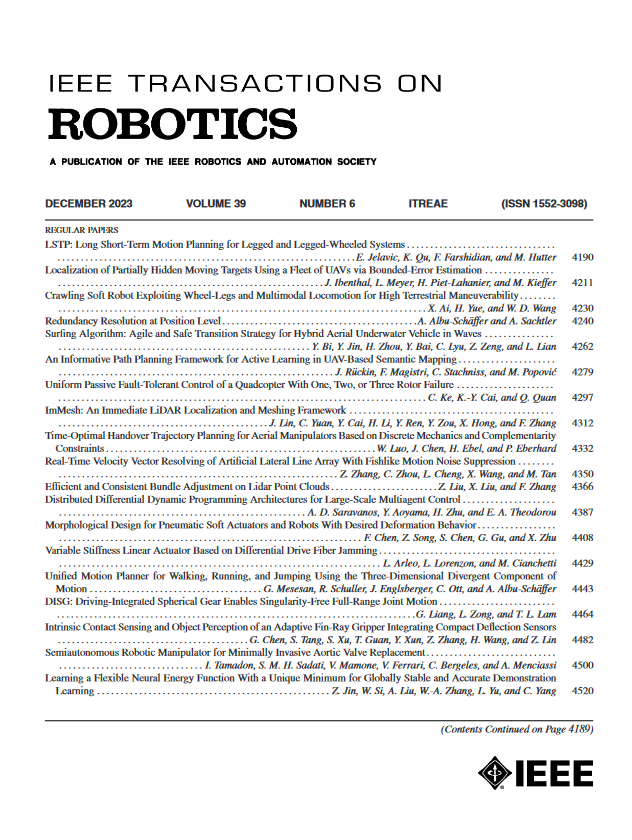A Compact 6D Suction Cup Model for Robotic Manipulation via Symmetry Reduction
IF 9.4
1区 计算机科学
Q1 ROBOTICS
引用次数: 0
Abstract
Active suction cups are widely adopted in industrial and logistics automation. Despite that, validated dynamic models describing their 6D force/torque interaction with objects are rare. This work aims at filling this gap by showing that it is possible to employ a compact model for suction cups, providing good accuracy also for large deformations. Its potential use is for advanced manipulation, planning, and control. We model the interconnected object-suction cup system as a lumped 6D mass-spring-damper systems, employing a potential energy function on一个紧凑的6D吸盘模型,通过对称减少机器人操作
主动吸盘广泛应用于工业自动化和物流自动化。尽管如此,描述它们与物体的6D力/扭矩相互作用的经过验证的动态模型很少。这项工作的目的是填补这一空白,表明它是可能采用一个紧凑的模型吸盘,提供良好的精度,也为大变形。它的潜在用途是高级操作、计划和控制。我们将相互连接的物体-吸盘系统建模为集总6D质量-弹簧-阻尼器系统,采用$\text {SE}(3)$上的势能函数,参数化为$6\ × 6$刚度矩阵。利用吸盘的几何对称性,将参数辨识问题从$6(6+1)/ 2 = 21$简化为$ $\boldsymbol{5}$独立参数,大大简化了参数辨识过程,否则将是病态的。提供实验验证并公开共享数据,以进一步刺激研究。作为稳态下可实现姿态预测的指示,对于约$\boldsymbol {1.75}$ kg的物体,我们获得了$\boldsymbol {5}$ mm和$\boldsymbol {3}$ deg的姿态误差,夹持器倾角为$\boldsymbol {60}$ deg。
本文章由计算机程序翻译,如有差异,请以英文原文为准。
求助全文
约1分钟内获得全文
求助全文
来源期刊

IEEE Transactions on Robotics
工程技术-机器人学
CiteScore
14.90
自引率
5.10%
发文量
259
审稿时长
6.0 months
期刊介绍:
The IEEE Transactions on Robotics (T-RO) is dedicated to publishing fundamental papers covering all facets of robotics, drawing on interdisciplinary approaches from computer science, control systems, electrical engineering, mathematics, mechanical engineering, and beyond. From industrial applications to service and personal assistants, surgical operations to space, underwater, and remote exploration, robots and intelligent machines play pivotal roles across various domains, including entertainment, safety, search and rescue, military applications, agriculture, and intelligent vehicles.
Special emphasis is placed on intelligent machines and systems designed for unstructured environments, where a significant portion of the environment remains unknown and beyond direct sensing or control.
 求助内容:
求助内容: 应助结果提醒方式:
应助结果提醒方式:


